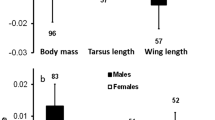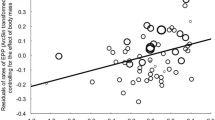Abstract
There is mounting evidence in a variety of taxa that females increase offspring quality by mating with multiple males, often resulting in multiple paternity. In birds, however, few studies have explicitly examined the benefits of mating with several different males; instead, the focus has been on whether or not extra-pair mating occurs, and its adaptive significance remains controversial. We examined the hypothesis that offspring quality, particularly immune response (phytohaemagglutinin assay) and growth, increases with the number of sires in broods of socially monogamous tree swallows (Tachycineta bicolor). We found one of the highest known levels of multiple paternity in birds (84% of nests with two or more extra-pair young had at least two extra-pair sires). Among nests with extra-pair young, the number and diversity of sires continued to increase linearly with the number of extra-pair young, so there was no evidence that some males monopolized paternity at high levels of extra-pair fertilization. Indeed, the number of sires was actually greater than expected in large broods, suggesting that some females might be seeking more mates. We found no effect of the number of sires on nestling immune response or growth. In mixed paternity broods, the immune response of extra-pair young did not differ from that of their within-pair half-siblings. However, among all broods, nestlings had a stronger immune response in nests with at least one extra-pair nestling than in nests with all within-pair nestlings. These results are not consistent with a good genes benefit of extra-pair mating, but they do suggest that there are environmental effects associated with extra-pair mating that increase nestling immune response. These environmental effects could produce indirect genetic effects on sexual selection if they are heritable. The extraordinarily high number of sires in this species highlights a relatively unexplored source of sexual selection in birds.



Similar content being viewed by others
References
Amos W, Wilmer JW, Fullard K, Burg TM, Croxall JP, Bloch D, Coulson T (2001) The influence of parental relatedness on reproductive success. Proc R Soc Lond B 268:2021–2027
Arnqvist G, Kirkpatrick M (2005) The evolution of infidelity in socially monogamous passerines: the strength of direct and indirect selection on extra-pair copulation behavior in females. Am Nat 165:S26–S37
Baer B, Schmid-Hempel P (1999) Experimental variation in polyandry affects parasite loads and fitness in a bumble-bee. Nature 397:151–154
Bitton P-P, O’Brien EL, Dawson RD (2007) Plumage brightness and age predict extrapair fertilization success of male tree swallows, Tachycineta bicolor. Anim Behav 74:1777–1784
Boag PT, Ratcliffe LM (2000) Genetics of avian mating systems. In: Apollonio M, Festa-Bianchet M, Mainardi D (eds) Vertebrate mating systems. World Scientific, Singapore, pp 307–332
Brookfield JFY (1996) A simple method for estimating the null allele frequency from heterozygote deficiency. Mol Ecol 5:453–455
Brown JL (1997) A theory of mate choice based on heterozygosity. Behav Ecol 8:60–65
Christe P, de Lope F, González G, Saino N, Møller AP (2001) The influence of environmental conditions on immune response, morphology and recapture probability of nestling house martins (Delichon urbica). Oecologia 126:333–338
Cohas A, Yoccoz NG, Allainé D (2007) Extra-pair paternity in alpine marmots, Marmota marmota: genetic quality and genetic diversity effects. Behav Ecol Sociobiol 61:1081–1092
Coltman DW, Pilkington JG, Smith JA, Pemberton JM (1999) Parasite-mediated selection against inbred Soay sheep in a free-living, island population. Evolution 53:1259–1267
Crowe SA, Kleven O, Delmore KE, Laskemoen T, Nocera JJ, Lifjeld JT, Robertson RJ (2009) Paternity assurance through frequent copulations in a wild passerine with intense sperm competition. Anim Behav 77:183–187
DiBattista JD, Feldheim KA, Gruber SH, Hendry AP (2008) Are indirect genetic benefits associated with polyandry? Testing predictions in a natural population of lemon sharks. Mol Ecol 17:783–795
Dunn PO, Afton AD, Gloutney ML, Alisaukas RT (1999) Forced copulation results in few extrapair fertilizations in Ross’s and lesser snow geese. Anim Behav 57:1071–1081
Edler R, Friedl TWP (2008) Within-pair young are more immunocompetent than extrapair young in mixed-paternity broods of the red bishop. Anim Behav 75:391–401
Firman RC, Simmons LW (2008) Polyandry facilitates postcopulatory inbreeding avoidance in house mice. Evolution 62:603–611
Fisher DO, Double MC, Blomberg SP, Jennions MD, Cockburn A (2006) Post-mating sexual selection increases lifetime fitness of polyandrous females in the wild. Nature 444:89–92
Forstmeier W, Coltman DW, Birkhead TR (2004) Maternal effects influence the sexual behavior of sons and daughters in the zebra finch. Evolution 58:2574–2583
Garant D, Dodson JJ, Bernatchez L (2005) Offspring genetic diversity increases fitness of female Atlantic salmon (Salmo salar). Behav Ecol Sociobiol 57:240–244
Garvin JC, Abroe B, Pedersen MC, Dunn PO, Whittingham LA (2006) Immune response of nestling warblers varies with extra-pair paternity and temperature. Mol Ecol 15:3833–3840
Gil D, Graves J, Hazon N, Wells A (1999) Male attractiveness and differential testosterone investment in zebra finch eggs. Science 286:126–128
Goodnight KF, Queller DC (1999) Computer software for performing likelihood tests of pedigree relationship using genetic markers. Mol Ecol 8:1231–1234
Goudet J (1995) FSTAT (Version 1.2): a computer program to calculate F-statistics. J Hered 86:485–486
Griffith SC (2007) The evolution of infidelity in socially monogamous passerines: neglected components of direct and indirect selection. Am Nat 169:274–281
Griffiths R, Double M, Orr K, Dawson R (1998) A DNA test to sex most birds. Mol Ecol 7:1071–1076
Groothuis TG, Eising CM, Dijkstra C, Müller W (2005) Balancing between costs and benefits of maternal hormone deposition in avian eggs. Biol Letters 1:78–81
Hoffman JI, Forcada J, Trathan PN, Amos W (2007) Female fur seals show active choice for males that are heterozygous and unrelated. Nature 445:912–914
Hoogland JL (1998) Why do female Gunnison’s prairie dogs copulate with more than one male? Anim Behav 55:351–359
Hopper KR, Rosenheim JA, Prout T, Oppenheim SJ (2003) Within-generation bet hedging: a seductive explanation? Oikos 101:219–222
Hussell D (1983) Age and plumage color in female tree swallows. J Field Ornithol 54:312–318
Jamieson A (1994) The effectiveness of using co-dominant polymorphic allelic series for (1) checking pedigrees and (2) distinguishing full-sib pair members. Anim Gen 25:37–44
Jeffreys AJ, Allen M, Hagelberg E, Sonnberg A (1992) Identification of the skeletal remains of Josef Mengele by DNA analysis. Forensic Sci Int 56:65–76
Jennions MD, Petrie M (2000) Why do females mate multiply? A review of the genetic benefits. Biol Rev 75:21–64
Johnsen A, Andersen V, Sunding C, Lifjeld JT (2000) Female bluethroats enhance offspring immunocompetence through extra-pair copulations. Nature 406:296–299
Lane JE, Boutin S, Gunn MR, Slate J, Coltman DW (2008) Female multiple mating and paternity in free-ranging North American red squirrels. Anim Behav 75:1927–1937
Lee PLM, Hays GC (2004) Polyandry in a marine turtle: females make the best of a bad job. Proc Nat Acad Sci USA 101:6530–6535
Lifjeld J, Robertson R (1992) Female control of extra-pair fertilizations in tree swallows. Behav Ecol Sociobiol 31:89–96
Lifjeld JT, Dunn PO, Whittingham LA (2002) Short-term fluctuations in cellular immunity of tree swallows feeding nestlings. Oecologia 130:185–190
Lochmiller RL, Vestey MR, Boren JC (1993) Relationship between protein nutritional status and immunocompetence in northern bobwhite chicks. Auk 110:503–510
Madsen T, Shine R, Loman J, Hakansson T (1992) Why do female adders copulate so frequently? Nature 355:440–441
Mäkinen T, Panova M, André C (2007) High levels of multiple paternity in Littorina saxatilis: hedging the bets? J Hered 98:705–711
Maklakov AA, Lubin Y (2004) Sexual conflict over mating in a spider: increased fecundity does not compensate for the costs of polyandry. Evolution 58:1135–1140
Martin LB, Han P, Lewittes J, Kuhlman JR, Klasing KC, Wikelski M (2006) Phytohemagglutinin-induced skin swelling in birds: histological support for a classic immunoecological technique. Func Ecol 20:290–299
McCarty JP (2001) Varation in growth of nestling tree swallows across multiple temporal and spatial scales. Auk 118:176–190
McKinney F, Evarts S (1998) Sexual coercion in waterfowl and other birds. In: Parker P, Burley N (eds) Avian reproductive tactics: female and male perspectives, vol 49. American Ornithologists’ Union, Washington, D.C., pp 163–195
Meek SB, Robertson RJ, Boag PT (1994) Extrapair paternity and intraspecific brood parasitism in eastern bluebirds revealed by DNA fingerprinting. Auk 111:739–744
Mitton JB, Schuster WSF, Cothran EG, DeFries JC (1993) Correlation between the individual heterozygosity of parents and their offspring. Heredity 71:59–63
Navara KJ, Hill GE, Mendona MT (2006) Yolk androgen deposition as a compensatory strategy. Behav Ecol Sociobiol 60:392–398
Neff BD, Pitcher TE, Ramnarine IW (2008) Inter-population variation in multiple paternity and reproductive skew in the guppy. Mol Ecol 17:2975–2984
O’Brien EL, Dawson RD (2007) Context-dependent genetic benefits of extra-pair mate choice in a socially monogamous passerine. Behav Ecol Sociobiol 61:775–782
Olsson M, Gullberg A, Tegelström H, Madsen T, Shine R (1994) Can female adders multiply? Nature 369:528
Otter K, Ratcliffe L, Boag PT (1998) Do female black-capped chickadees prefer high-ranking males as extra-pair partners? Behav Ecol Sociobiol 43:25–36
Parker G (1990) Sperm competition games: raffles and roles. Proc R Soc Lond B 242:120–126
Petit R, el Mousadik A, Pons O (1998) Identifying populations for conservation on the basis of genetic markers. Conserv Biol 12:844–855
Poirier NE, Whittingham LA, Dunn PO (2004) Males achieve greater reproductive success through multiple broods than through extrapair mating in house wrens. Anim Behav 67:1109–1116
Richardson DS, Jury FL, Dawson DA, Salgueiro P, Komdeur J, Burke T (2000) Fifty Seychelles warbler (Acrocephalus sechellensis) microsatellite loci polymorphic in Sylviidae species and their cross-species amplification in other passerine birds. Mol Ecol 9:2225–2229
Robertson RJ, Rendell WB (2001) A long-term study of reproductive performance in tree swallows: the influence of age and senescence on output. J Anim Ecol 70:1014–1031
Robertson RJ, Stutchbury BJ, Cohen RR (1992) Tree Swallow. In: Poole A, Stettenheim P, Gill F (eds) The Birds of North America, no 11. Academy of Natural Sciences, Philadelphia, pp 1–28
SAS Institute (2003) JMP 5.0.1 User’s guide. SAS Institute, Cary, NC
Schmoll T, Dietrich V, Winkel W, Epplen JT, Schurr F, Lubjuhn T (2005) Paternal genetic effects on offspring fitness are context dependent within the extrapair mating system of a socially monogamous passerine. Evolution 59:645–657
Schmoll T, Schurr FM, Winkel W, Epplen JT, Lubjuhn T (2007) Polyandry in coal tits Parus ater: fitness consequences of putting eggs into multiple genetic baskets. J Evol Biol 20:1115–1125
Simmons LW (2005) The evolution of polyandry: sperm competition, sperm selection and offspring viability. Ann Rev Ecol Evol Syst 36:125–146
Smits JE, Bortolotti GR, Tella JL (1999) Simplifying the phytohemagglutinin skin testing technique in studies of avian immunocompetence. Func Ecol 13:567–572
Sprenger D, Anthes N, Michiels N (2008) Multiple mating affects offspring size in the opisthobranch Chelidonura sandrana. Mar Biol 153:891–897
Stapleton M, Kleven O, Lifjeld J, Robertson R (2007) Female tree swallows (Tachycineta bicolor) increase offspring heterozygosity through extrapair mating. Behav Ecol Sociobiol 61:1725–1733
Tregenza T, Wedell N (1998) Benefits of multiple mates in the cricket Gryllus bimaculatus. Evolution 52:1726–1730
Tregenza T, Wedell N, Hosken DJ, Ward PI (2003) Maternal effects on offspring depend on female mating pattern and offspring environment in yellow dung flies. Evolution 57:297–304
Venier LA, Robertson RJ (1991) Copulation behaviour of the tree swallow, Tachycineta bicolor: paternity assurance in the presence of sperm competition. Anim Behav 42:939–948
Venier LA, Dunn PO, Lifjeld JT, Robertson RJ (1993) Behavioural patterns of extra-pair copulation in tree swallows. Anim Behav 45:412–415
Whitlock MC, Schluter D (2009) The analysis of biological data. Roberts , Greenwood Village
Whittingham L, Dunn P (2000) Offspring sex ratios in tree swallows: females in better condition produce more sons. Mol Ecol 9:1123–1129
Whittingham LA, Dunn PO, Stapleton MK (2006) Repeatability of extra-pair mating in tree swallows. Mol Ecol 15:841–849
Whittingham LA, Dunn PO, Lifjeld JT (2007) Egg mass influences nestling quality in tree swallows, but there is no differential allocation in relation to laying order or sex. Condor 109:585–594
Yasui Y (1998) The ‘genetic benefits’ of female multiple mating reconsidered. Trends Ecol Evol 13:246
Yasui Y (2001) Female multiple mating as a genetic bet-hedging strategy when mate choice criteria are unreliable. Ecol Res 16:605–616
Zach R (1982) Hatching asychrony, egg size, growth, and fledging in tree swallows. Auk 99:695–700
Zeh JA, Zeh DW (1996) The evolution of polyandry I: intragenomic conlict and genetic incompatibility. Proc R Soc Lond B 263:1711–1717
Zeh JA, Zeh DW (2006) Outbred embryos rescue inbred half-siblings in mixed-paternity broods of live-bearing females. Nature 439:201–203
Acknowledgments
We thank Mary Stapleton and Stacy Valkenaar for assistance in the field and the staff at University of Wisconsin-Milwaukee (UWM) Field Station for logistic support. Bryan Neff helped with the simulation model, and Jeff Graves, Bart Kempenaers, Dustin Rubenstein, and an anonymous reviewer provided helpful comments on the manuscript. This study was approved by the Animal Care and Use Committee at UWM (protocol 99-00#19). The project was funded by the National Science Foundation (LAW and POD) and the Nansen Endowment (JTL). JTL was supported by a grant from the University of Oslo and the Research Council of Norway during a sabbatical stay at UWM.
Author information
Authors and Affiliations
Corresponding author
Additional information
Communicated by J. Graves
Rights and permissions
About this article
Cite this article
Dunn, P.O., Lifjeld, J.T. & Whittingham, L.A. Multiple paternity and offspring quality in tree swallows. Behav Ecol Sociobiol 63, 911–922 (2009). https://doi.org/10.1007/s00265-009-0734-5
Received:
Revised:
Accepted:
Published:
Issue Date:
DOI: https://doi.org/10.1007/s00265-009-0734-5




